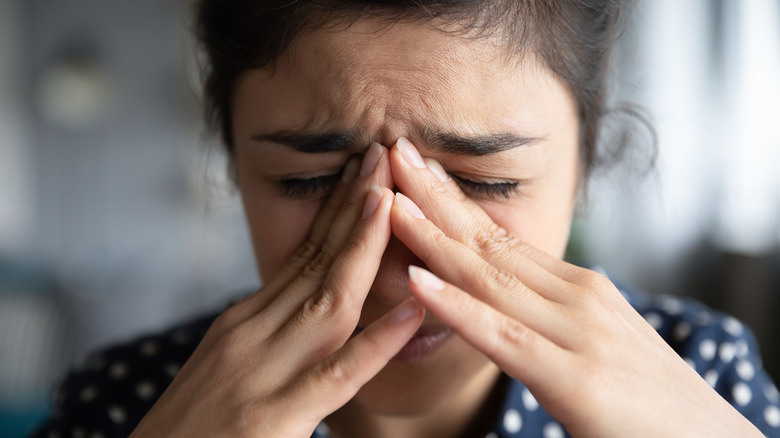How To Tell The Difference Between A Migraine, Tension Headache, And Sinus Headache
While all headaches are a pain, they are not all created equal. The first step in tackling your pounding head is to first figure out which kind of headache you're dealing with. According to WebMD, tension headaches occur more than migraines, but that doesn't necessarily mean you should rule out other options. Different headaches call for different treatments.
When experiencing a migraine, you will often feel it on just one side of your head, although it can also manifest on both sides (via Mayo Clinic). Migraines cause incredibly intense pain in your head and face to the point where it may trigger nausea and vomiting. According to Healthline, before a migraine begins, you may feel a tingling sensation in your face or experience a temporary loss of vision. Migraine pain can also cause nausea, extreme sensitivity to light and sound, vomiting, and dizziness.
A particular aspect of migraines not found in other types of headaches is auras. According to the Cleveland Clinic, a migraine aura may be experienced before the beginning of a migraine and occurs as a change in your vision — commonly through seeing spots or a flash of light.
Treatments for migraines can vary but most commonly include prescription or over-the-counter medicine as well as implementing lifestyle changes to manage stress (via Healthline).
What is a tension headache?
A tension headache differs from a migraine in that is more common and tends to be much less intense (via WebMD). According to Johns Hopkins Medicine, a tension headache causes a general ache that is felt throughout the head and neck. While tension headaches may range from mild to moderate on the pain scale, they can still create an upheaval in your life if they are not treated.
There is a wide range of reasons why you may be experiencing a tension headache. Most commonly, they are caused by stress (via Johns Hopkins). When we are stressed, we tend to tense our muscles — particularly in the face and neck. This prolonged muscle tension can lead to a tension headache.
The most common treatment for tension headaches are over-the-counter medicines as well as getting some caffeine into your system (via WebMD). According to the Mayo Clinic, practicing mindfulness techniques such as yoga and meditation may help to prevent tension headaches from occurring.
Dealing with a sinus headache
"Migraine and tension headaches are primary headaches, while sinus is a secondary headache," neurologist Rahul Chakor told The Better India. "Simply put, in primary headaches, the pain in your head itself is the problem. Whereas, in sinusitis, the headache is secondary to another condition, in this case, sinusitis."
According to the Mayo Clinic, sinus headaches are caused by an infection and are characterized by pressure in your face, particularly around your eyes and nose. They can feel worse when you lay down and may also be accompanied by a fever. Although sinus headaches can resemble migraines in the intensity of the throbbing in the face, the origins of the two types of headaches are vastly different and therefore require different treatments, per the American Migraine Foundation.
To treat a sinus headache, it is recommended that you remain elevated as you sleep, drink plenty of water, and relieve your sinuses with steam (via Healthline). Using an over-the-counter medication can also help with the pain associated with a sinus headache.



